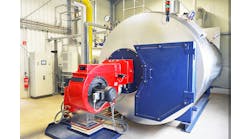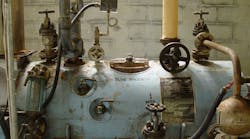The HUD (Housing and Urban Development) organization was developed by the federal government in 1965 to assist in the development of low income and subsidized housing for seniors, veterans and the financially disadvantaged. It began developing housing in multi-family, multiple story buildings throughout the United States. The obvious choice of providing heating comfort was the use of hydronics.
In most cases, the “state of the art” heating systems at the time were appliances with a basic thermal efficiency of around 60 to 80 percent. Overall system efficiencies were relatively low due to the redundant use of boilers and pumps. Energy efficiency was not a major concern when these systems were developed, and their costs of operation were also subsidized by the federal government. Many of these original systems are still in operation and their annual maintenance costs have risen significantly.
Some of these original systems have degraded to the point that the controls which regulate the flow have either failed and have been bypassed, or are in the process of failing due to age and are in need of upgrades and/or replacements. This is rather apparent when you pull up in front of the building when it is cold and see that more than half of the windows are wide open.
If the distribution system is in bad shape, just replacing the boilers may not show the greatest energy savings potential.
On most of these properties, the energy costs are included in their subsidized rent, so the occupants aren’t really affected by this obvious waste of energy. They are just trying to stay comfortable, and keeping their windows open is the only way they have of controlling their discomfort. This is what I refer to as the “Double Hung” thermostat. It generally happens due to the mistake of not allocating enough money for the regular maintenance of the system and its components. Subsequently, the maintenance department, who is charged with the primary responsibility of providing heat (a federal requirement) props open the control valves serving a given unit, or in some cases, completely guts the internal workings of the control valve to get flow to the final heat emitters.
The federal government recently instituted a “Base Lining” energy evaluation program to look at these subsidized properties to get an idea of how much energy they are consuming in comparison to other typical systems. This is where the red flags show up. Those properties with the open windows often end up showing the highest energy consumption per square foot per occupant.
In an effort to stem this flow of energy dollars, many buildings are candidates for hydronic heating system retrofits. I use the term “heating system” because simply replacing the boiler may result in some energy savings, but if the distribution system is in bad shape, just replacing the boilers may not show the greatest energy savings potential, especially in situations where the distribution system has suffered a great deal of “deferred maintenance”.
A person has to look outside of the boiler room in order to fully gage the energy savings potential. Boilers represent the most obvious low hanging fruit, but the overall system needs to be assessed and diagnosed before a good decision can be made as to where the properties’ investments should occur.
Tune in again next month as we delve into all the moving parts of these buildings—including the occupants—to come up with a good game plan for retrofit conservation.
Until then, happy hydronicing!
Mark Eatherton material, in print and online, is protected by Copyright 2017. Any reuse of this material (print or electronic) must first have the express written permission of Mark Eatherton and CONTRACTOR magazine. Please contact via email at [email protected].


